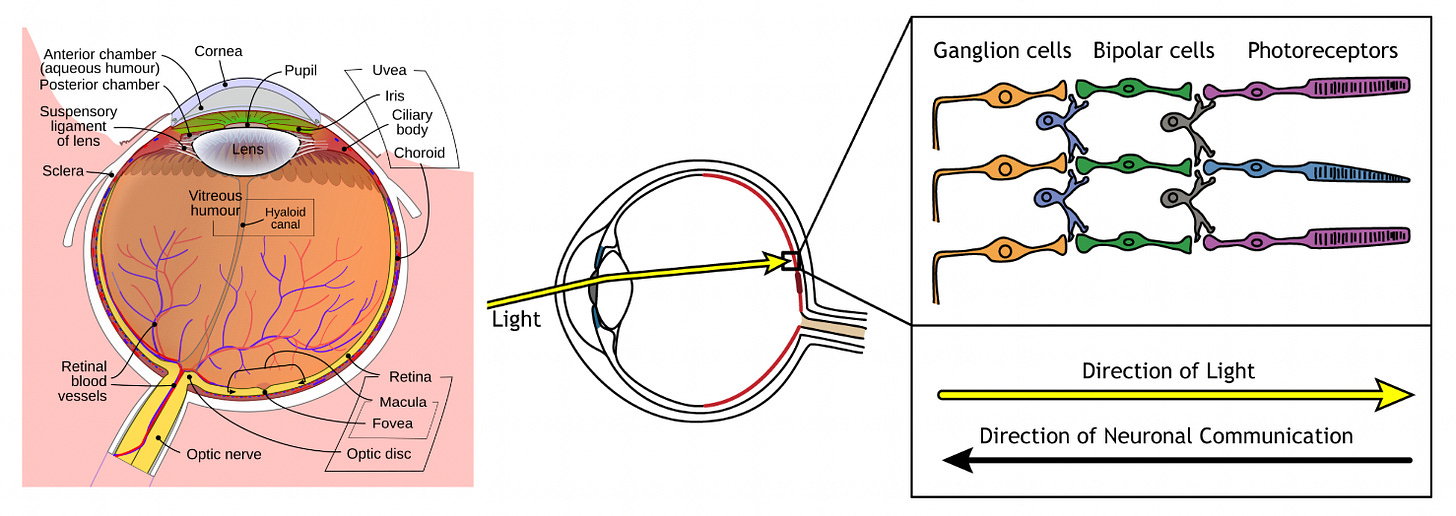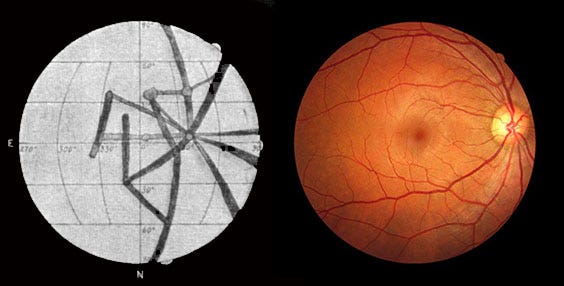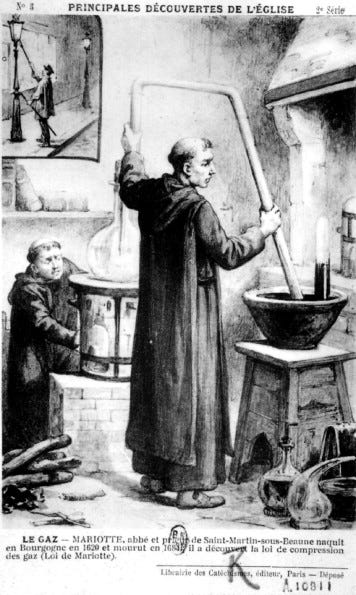Staring at the blind spot
How did we not notice the hole in our vision for so long? Also: octopus eyes, spokes on Venus, and perceptual con jobs
As a species, we know many things. Like how birds sense magnetic fields, how a giraffe maintains its blood pressure, and why all humans have a blind spot in their vision. I find it fascinating to learn how we came to know what we know.
I previously wrote about the history of color science — how scientists predicted that our eyes must contain three different types of color-sensitive cells (cones) in the eye based on the observation that all perceivable colors can be created by combining three distinct colors. In that case, scientists first studied our perception of color and then predicted what they would find in biology, a prediction that was confirmed more than 150 years later. But it is possible that history could have taken a different route—one in which we first studied the eye and discovered that there were three types of cones, leading us to confirm that our perception of color was indeed ‘trichromatic’.
Somehow, this feels unlikely to me. This is partially due to a failure of my imagination, but also because there were many incentives to understand color perception at the behavioral level, given its impact on art, printing, and in building color displays. We would’ve only invented color photography in the second half of the 20th century if we had waited for experimental techniques in biology to advance enough to let us study the eye in detail.
The discovery of the blind spot offers a counterexample. Here, a behavioral observation, so easy to demonstrate that it requires no apparatus, was only discovered because of experiments prompted by anatomical findings. In this post, I’ll discuss how, for me, learning about the blind spot has been illuminating.
What is the blind spot? All of us have an area in the visual field of each eye where we are completely blind.
To find it, close one of your eyes and look at the X corresponding to the open eye (red for right, blue for left). Continue fixating and move towards or away from the screen. At some distance, the other X should entirely disappear. (Check footnote if it didn’t work for you1)
Why do we have a blind spot? Because the human eye is wired backwards.
Weirdly Wired Eyes

When light enters the eye, it first has to make its way through the cornea, lens, blood vessels, and vitreous (the gel-like stuff that fills most of the space in the eye). Only then does it reach the retina - a thin sheet of tissue at the back of the eye that contains special cells called photoreceptors that convert light to electricity. An image of the outside world is projected onto the retina. So each photoreceptor receives light from a particular location in our field of view. The output of the photoreceptors goes through many other layers of cells within the retina, which further process the information before sending it to the brain.
The output from these retinal cells needs to get to the brain. This happens at a small oval region called the optic disc. Here, a bundle of nerve fibers, aptly named the optic nerve, exits the eye to reach into the brain and set up the electric storm that conjures our perception2. There are no photoreceptors on the optic disc. Therefore, the part of the visual field corresponding to this spot is invisible to the brain - this is our blind spot.
The backwards wiring seems to be an evolutionary quirk of the vertebrate eye, but one that is not a necessity for all eyes: Cephalopod (octopus / squid) eyes, which evolved independently of vertebrate eyes, have their photoreceptors in the front and other cells behind that. So, the marvelous Octopuses, on top of having three hearts and a decentralized nervous system, also have camera-like eyes that are devoid of blind spots.
There’s a simple but neat demonstration of the backwards wiring of the eye. To carry this out, you’ll need to construct a pinhole camera. You can do this either by making a tiny hole in a piece of cardboard or paper, or just bending your index finger3 to only let light in through a small hole. Close one eye and look at a blank, bright surface through the pinhole with the other. Now, shake the pinhole in little circles. Make sure the extent of your shakes is smaller than the size of the hole, so you're still looking at the same spot on the wall. You should see many branched tree-like shadows against the background. These are shadows cast by the blood vessels inside your eye onto the retina - sometimes called Purkinje trees4. This was first described by Jan Evangelista Purkynje, who also lent his name to the beautiful Purkinje cells.
Our weirdly wired eyes, while mostly harmless, might have led one 19th century astronomer astray. Percival Lowell famously made many drawings of the planet Venus where he reported that he observed “a central dark spot and a spindly spoke pattern on the cloud enshrouded planet”. This was a controversial claim, and not many believed him. Almost a century later, a couple of astronomers revisited this claim in an issue of Sky & Telescope detailing how Lowell had set up his telescope’s exit pupil (the aperture that determines how much light passes) to be extremely tiny. Soon, a few readers, who also happened to be optometrists, wrote in to suggest that what Lowell must’ve seen were not spokes on Venus but rather the blood vessels in his own eyes!

Dissect first, Perceive later
Setting aside this fun digression and going back to the discovery of the blind spot: Edme Mariotte 5, a founding member of l'Académie des sciences de Paris, was the first to demonstrate the existence of a perceptual blind spot and publish it in his 1668 book called 'A New Discovery concerning Vision'.

Here's an excerpt from his book (quote from Grzybowski and Aydin):
“... upon the anatomy of Men as well as of Animals that the Optic Nerve is never located exactly in the middle of the fundus of the Eye … and that in man it is a bit higher and on the side leading toward the Nose.” The aim of the experiment was to test “whether vision is stronger or weaker at the site of the Optic Nerve.”6
Anatomists who dissected the eye had noticed that the optic disc was never at the center of the eye, but a few millimeters towards the nose. Mariotte devised the simple experiment that I described above to probe how the optic disc impacts our vision. In contrast to the history of color science, here it was the anatomical observation of the optic disc’s location that prompted Mariotte to investigate its implications for our visual perception.
Imagine a parallel world where an academic interested in the mysteries of binocular vision or a scientifically-minded pirate blinded in one eye happened to stumble upon this curious observation that a part of their visual field was missing7. Perhaps they might've then carefully dissected a human eye and found, to their delight, that the blind spot was perfectly explained by the bundle of nerves leaving the eye.
I'm not sure why I find it so amusing that the path of history led us to first learn about the anatomy before observing its behavioral consequence. Maybe it’s because of how easy it is for each of us to test for the blindspot, compared to the obvious difficulty of dissecting an eye. I'm sure I'm falling prey to hindsight bias, but this does make me wonder what other simple facts of nature we'll discover in the future that were staring us right in the eye all along, waiting for someone to point at it!
The great con job of perception
If we all have blind spots, how come we aren’t walking around seeing two holes in our vision? With both eyes open, the brain makes up for the missing information at that location using input from the other eye. But even when we close one of our eyes, we still don’t notice a hole.
Let’s go back to our blind spot demonstration. Keep your right eye fixed on the red X while closing your left. Move towards or away till the blue circle disappears. Hold this position and start the video.
After a few seconds, the circle on the right will change. With only your right eye open, if the blue circle falls exactly on your blind spot, all you should see is a large orange circle followed by a bunch of horizontal lines. But with both eyes open, you will notice that: (1) it turned into an orange ‘annulus’ or donut with nothing in the center, (2) we added back in the little blue circle, (3) we changed it to a green circle, and (4) the lines were occluded by a white circle in the middle.
For those of you interested, here’s an extra little experiment: Follow the same instructions as before and make sure the green circle is in your blind spot.
What does the final image look like to you?8
All of this is thanks to our brains ‘filling-in’ using information from the surrounding parts of the visual field.
“We should expect, whether we use one or both eyes, to see a black or dark spot upon every landscape within 15° of the point which most particularly attracts our notice. The Divine Artificer, however, has not left his work thus imperfect ... the spot, in place of being black, has always the same colour as the ground” - David Brewster, letters on natural magic (1883)
The brain is being pragmatic: usually, the properties of nearby patches of the external world are similar. This evolutionary ‘prior’ for continuity has shaped the way our brains infer what is really out there based on noisy and often inadequate inputs.
The blind spot test is my favorite 'fun fact' neuroscience demo. It's such a compelling demonstration, and a simple way to remind us that we see with our brains, not just our eyes. I’m biased, but I think neuroscience is unique amongst the sciences. The brain is both the subject and the scientist. What I’m trying to understand is me. Yet this doesn’t isolate us. Some philosophers claim that we can never know what it’s like to be another person. But how amazing is it that Mariotte reported his perception of the blind spot in 1668, and three hundred and fifty seven years later, you and I can have the same experience he did!
“Contemplate the marvel that is existence, and rejoice that you are able to do so. I feel I have the right to tell you this because, as I am inscribing these words, I am doing the same.” - Ted Chiang9
If you liked this, you might also enjoy:
The quest for consciousness - book by Christof Koch (Credit for the phrase “the great con job of perception”)
Seeing - short story by Greg Egan (in Axiomatic)
Becoming a neuroscientist
Please let me know if you spot any errors. I'd like to be as accurate as possible, and I appreciate your feedback.
This works better on the desktop/laptop than on the phone. You can still do it on the phone, you just have to hold it really close to your face and a little off to the side of the open eye.
You can also do it without the image - just extend your right arm out and make a thumbs-up sign. With the left eye closed, look straight ahead with your right eye and slowly move your hand to the right while wiggling your thumb. At some point, the tip of your thumb should disappear.
‘Electric storm’ is a reference to a wonderful essay by Charles Sherrington called ‘The making of the eye’
Why don’t we see these purkinje trees all the time? It’s because of sensory adaptation: sensory processing in the brain is really about noticing differences: what changed from the last moment to now. Since the shadows of the blood vessels are constant, the cells ‘adapt’ to them, i.e. they stop responding to them.
Similar to the protagonists of the story of color science, Mariotte was also a physicist (i.e. 'future neuroscientist') who (independent of Boyle) discovered the Boyle-Mariotte's law.
Back then, the prevailing hypothesis had been that vision would be 'best' at the optic disc, and Mariotte's findings were considered controversial
William Cheselden, a surgeon-anatomist (1688–1752), recognised the potential hazards of a blind spot in an only eye. He related the unfortunate tale of ‘a gentleman, who having lost one eye by the smallpox’, walked through a hedge in which ‘a thorn unseen … struck the other and put it out’.
I came across this in a fun paper by Hui Li and colleagues. If you’re curious what others saw, they reported that for “bi-colored annuli, where one half had a given color, while the other half had a different one, filled in the blind spot asymmetrically. Specifically, the color surrounding the nasal half typically filled in about 75% of the blind spot area, whereas the color surrounding the temporal half filled in only about 25%.”
I have an obsessive need to quote Ted Chiang at least once a day.
Image credits
(1) Schematic_diagram_of_the_human_eye_with_English_annotations.svg - Rhcastilhos and Jmarchn., CC BY-SA 3.0
(2) Eye Anatomy - Casey Henley CC BY-NC-SA) 4.0 International License
(3) Vincent van Gogh, Public domain, via Wikimedia Commons







